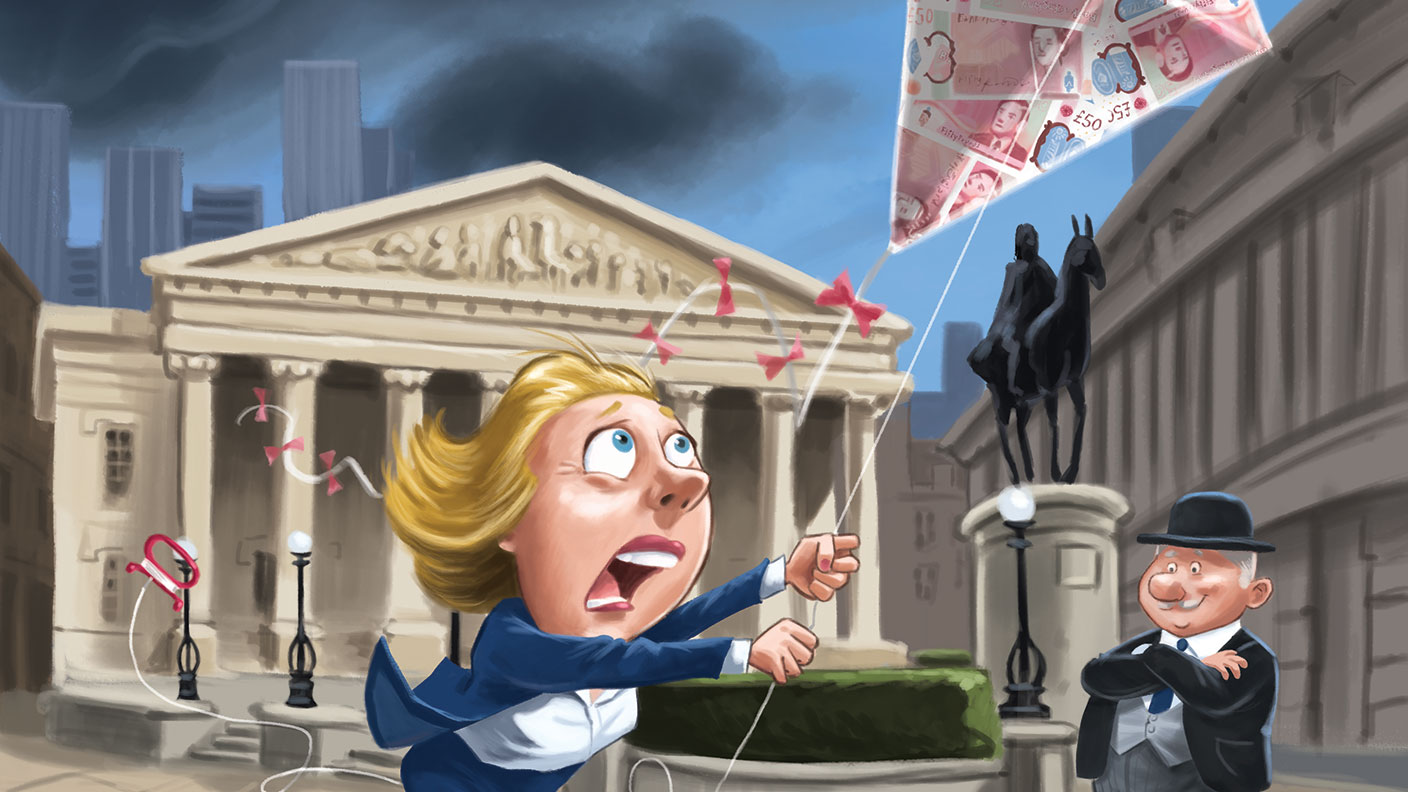Inflation is here to stay: it’s time to protect your portfolio
Unlike in 2008, widespread money printing and government spending are pushing up prices. Central banks can’t raise interest rates because the world can’t afford it, says John Stepek. Here’s what happens next


Last April, when coronavirus was tearing around the globe and most Western economies were tightly shut down, we argued in MoneyWeek that central-bank and government policies designed to tackle the crisis were likely to result in inflation. What with rampant unemployment, a huge (if short) recession, and oil prices turning negative, you could have been forgiven for being sceptical.
Yet here we are, a year and a bit later, and prices everywhere are indeed picking up. Notably, inflation in the US is at multi-decade highs regardless of the precise inflation index you use to measure it (in June, consumer prices were up by 5.4% year-on-year), while oil – which you literally couldn’t give away in April last year – is back around the $70-a-barrel mark.
Yet no one seems too concerned by this turn of events. The world’s central banks keep telling investors that price rises are just “transitory” and that they will pass once the initial supply shocks are over. Investors appear to believe them. “Reflation” trades (such as buying “value” stocks and commodities) did well for much of 2020 and early 2021, but in recent months they’ve given way to the same old growth plays that dominated prior to Covid-19, while bond markets have rallied since late March. So are we wrong to expect inflation to be more persistent, or is there something else going on here?
MoneyWeek
Subscribe to MoneyWeek today and get your first six magazine issues absolutely FREE

Sign up to Money Morning
Don't miss the latest investment and personal finances news, market analysis, plus money-saving tips with our free twice-daily newsletter
Don't miss the latest investment and personal finances news, market analysis, plus money-saving tips with our free twice-daily newsletter
The bond market isn’t psychic
In financial markets, bond investors are often viewed as “the smartest guys in the room”, particularly relative to flighty equity investors. Bonds mostly pay out a fixed income, which loses its value in real (after-inflation) terms as prices (and interest rates) rise. So they should be particularly sensitive to where inflation might go from here – and they certainly don’t seem to be worried. Current yields on US Treasuries (and global government bonds generally) imply that investors think that central banks are right, and that inflation will indeed be “transitory”.
Yet even the smartest people in the room aren’t psychic. For a recent analysis, Joseph Gagnon and Madi Sarsenbayev of the Peterson Institute for International Economics looked back at around 70 years of data for the US, the UK, Japan and France, and found that in each case ten-year bond yields didn’t in fact predict the likely path of inflation over the decade ahead, but instead reflected the average inflation rate over the prior ten years. Given human beings’ tendency to extrapolate, this shouldn’t come as a surprise, but it does mean that those assuming that the lack of alarm in the bond market is a reassuring sign may be in for a nasty shock.
Mohamed El-Erian, formerly of giant bond specialist Pimco, now chief economic adviser at Allianz, thinks the market definitely has the wrong end of the stick on this occasion. “Inflation is not going to be transitory. I’ve been pretty certain in my mind about three prior calls. This is the fourth one,” he tells Bloomberg.
For the curious, El-Erian’s other three big calls were: Argentina would default (it did); Brazil would not (it did not); and a “new normal” of slower economic growth would follow the 2008 crisis (it did). So why does the bond market have it so wrong now? El-Erian says there is a very simple explanation: the US Federal Reserve keeps buying bonds.
This time it’s different
But why might the bond market have got this wrong? Why isn’t inflation transitory? The last crisis we faced before the Covid-19 shutdown was the 2008 financial crisis. Quantitative easing (QE), or money printing, didn’t turn out to be inflationary back then, so why should it now? The reason is that this is an entirely different type of crisis. Indeed, it’s almost the exact opposite of 2008. It should already be obvious that this is the case.
You need only look at how rapidly the economy has rebounded. Analysis by Deutsche Bank notes that the post-Covid-19 rebound in US GDP has been the fastest seen since World War II. By contrast, the recovery that followed 2008 was one of the slowest. Meanwhile, economic forecasters are rapidly revising down the levels of lasting damage (“scarring”) that they expect to see as a result of this recession.
Yet not only have central banks been more aggressive with their money-printing than in 2008, but this time governments have also joined in. As Charles Goodhart of the London School of Economics tells The Wall Street Journal: “The generals are always fighting the last war. Governments didn’t do enough before, so they’re going to overdo it this time”.
Looked at in more detail, it becomes even clearer just how drastically different things are today. In the wake of 2008, both banks and households were over-indebted and desperately trying to avoid bankruptcy. The slashing of interest rates and printing of money kept many households afloat and bought time for banks gradually to write off their bad debts without admitting to being bust. But even with copious QE, that process took time, which accounts for the slowness of the recovery.
Now, by contrast, both banks and consumers have plenty of money. James Ferguson of MacroStrategy notes that, according to Refinitiv Datastream data, since 1962, US households’ bank deposits have averaged 52% of GDP, and have generally not gone below 47% or above 57%. Today US bank deposits are equivalent to 66% of GDP. Even if we accept the (highly contentious) argument that consumers will permanently maintain a higher level of precautionary savings owing to the shock of the pandemic, it’s hard to imagine that they’ll remain this elevated.
Even at the top of that historic range, we’re looking at 11% of US GDP either being spent (consumed) or invested in the near future. Note that on the latter point, as Eric Platt in the Financial Times reported last month, global equity funds are already on track to “take in more money in 2021 than in the previous 20 years combined”.
Meanwhile, notes Ferguson, “today the banks’ capital-to-asset ratios are about double what they were before the [2008 financial crisis] while, due to generous fiscal support mechanisms”, there are no bad debts looming on the horizon. As a result, banks have plenty of money sitting in “safe” assets earning low returns and are now eager to start lending that out in order to boost their margins. Demand for loans is picking up too as companies ramp up investment in the wake of the Covid-19 shutdowns.
Put simply, after 2008 the collective private-sector balance sheet was like an empty, leaky bucket – the QE hose eventually managed to fill it up, but it took a long time. Today is entirely different. We went into this crisis with the bucket in pretty good shape and now we’re coming out of it, it’s already brimming over.
As Ferguson puts it: “if the problem was that households and businesses were overleveraged going into the financial crisis, both sectors will be coming out of this recession over-liquid”. Even if you’re an inflation-sceptic, you have to acknowledge that it’s very hard to make the case that the post-Covid-19 environment is anything like the post-2008 one.
Don’t expect central banks to wade in
We’re already seeing the effects of all this. Despite high unemployment levels, companies across the world are struggling to fill positions, while those who are already in employment are happily quitting to get better-paid jobs elsewhere, often in different sectors (hence the exodus from the hospitality industry).
Labour isn’t the only cost that’s rising. Raw materials – everything from tin to oil to copper – have surged in the past year too, as have transport costs. Some of these supply issues will be temporary. But many companies are already passing these cost increases on rather than absorbing them. There is a confidence that the market will bear higher prices (which in turn is at least partly down to the amount of money in circulation) and so far that confidence is being borne out.
Won’t central banks respond to this? Another reasons why markets are buying into the “transitory” argument is the belief that if inflation does turn out to be more enduring, then central banks have the tools to deal with it. This belief persists despite the fact that central banks keep signalling that they have more on their minds than just price rises.
To read the whole of this article, subscribe to MoneyWeek magazine
Subscribers can see the whole article in the digital edition available here
Get the latest financial news, insights and expert analysis from our award-winning MoneyWeek team, to help you understand what really matters when it comes to your finances.
John Stepek is a senior reporter at Bloomberg News and a former editor of MoneyWeek magazine. He graduated from Strathclyde University with a degree in psychology in 1996 and has always been fascinated by the gap between the way the market works in theory and the way it works in practice, and by how our deep-rooted instincts work against our best interests as investors.
He started out in journalism by writing articles about the specific business challenges facing family firms. In 2003, he took a job on the finance desk of Teletext, where he spent two years covering the markets and breaking financial news.
His work has been published in Families in Business, Shares magazine, Spear's Magazine, The Sunday Times, and The Spectator among others. He has also appeared as an expert commentator on BBC Radio 4's Today programme, BBC Radio Scotland, Newsnight, Daily Politics and Bloomberg. His first book, on contrarian investing, The Sceptical Investor, was released in March 2019. You can follow John on Twitter at @john_stepek.
-
 ‘Why I have ditched my Help to Buy ISA for cash savings and the stock market’
‘Why I have ditched my Help to Buy ISA for cash savings and the stock market’Without the 25% bonus, my Help to Buy ISA is effectively redundant, says MoneyWeek writer Sam Walker.
-
 Is your inheritance tax allowance cut if you sell to downsize or sell your home to pay for care?
Is your inheritance tax allowance cut if you sell to downsize or sell your home to pay for care?Downsizing relief is a little-known benefit that could save your loved ones tens of thousands of pounds in inheritance tax after you’ve died.
-
 The steady rise of stablecoins
The steady rise of stablecoinsInnovations in cryptocurrency have created stablecoins, a new form of money. Trump is an enthusiastic supporter, but its benefits are not yet clear
-
 Goodwin: A superlative British manufacturer to buy now
Goodwin: A superlative British manufacturer to buy nowVeteran engineering group Goodwin has created a new profit engine. But following its tremendous run, can investors still afford the shares?
-
 A change in leadership: Is US stock market exceptionalism over?
A change in leadership: Is US stock market exceptionalism over?US stocks trailed the rest of the world in 2025. Is this a sign that a long-overdue shift is underway?
-
 Modern Monetary Theory and the return of magical thinking
Modern Monetary Theory and the return of magical thinkingThe Modern Monetary Theory is back in fashion again. How worried should we be?
-
 Metals and AI power emerging markets
Metals and AI power emerging marketsThis year’s big emerging market winners have tended to offer exposure to one of 2025’s two winning trends – AI-focused tech and the global metals rally
-
 King Copper’s reign will continue – here's why
King Copper’s reign will continue – here's whyFor all the talk of copper shortage, the metal is actually in surplus globally this year and should be next year, too
-
 The coming collapse in the jobs market
The coming collapse in the jobs marketOpinion Once the Employment Bill becomes law, expect a full-scale collapse in hiring, says Matthew Lynn
-
 Renewable energy funds are stuck between a ROC and a hard place
Renewable energy funds are stuck between a ROC and a hard placeRenewable energy funds were hit hard by the government’s subsidy changes, but they have only themselves to blame for their failure to build trust with investors
